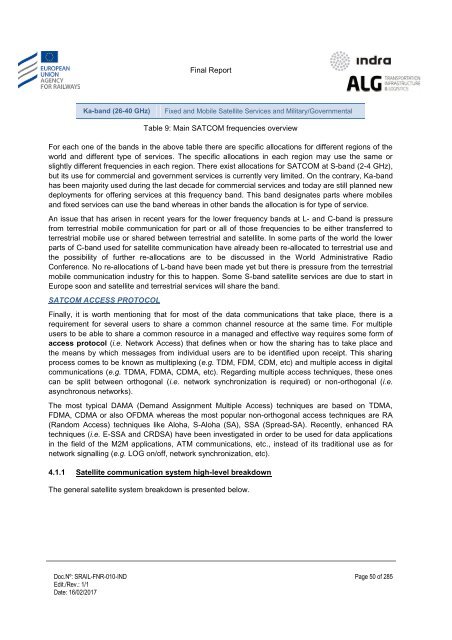Study on feasibility of SATCOM for railway communication
SRAIL-FNR-010-IND%20-%20FinalReport_v1.1_20170216
SRAIL-FNR-010-IND%20-%20FinalReport_v1.1_20170216
Create successful ePaper yourself
Turn your PDF publications into a flip-book with our unique Google optimized e-Paper software.
Final Report<br />
Ka-band (26-40 GHz)<br />
Fixed and Mobile Satellite Services and Military/Governmental<br />
Table 9: Main <strong>SATCOM</strong> frequencies overview<br />
For each <strong>on</strong>e <strong>of</strong> the bands in the above table there are specific allocati<strong>on</strong>s <strong>for</strong> different regi<strong>on</strong>s <strong>of</strong> the<br />
world and different type <strong>of</strong> services. The specific allocati<strong>on</strong>s in each regi<strong>on</strong> may use the same or<br />
slightly different frequencies in each regi<strong>on</strong>. There exist allocati<strong>on</strong>s <strong>for</strong> <strong>SATCOM</strong> at S-band (2-4 GHz),<br />
but its use <strong>for</strong> commercial and government services is currently very limited. On the c<strong>on</strong>trary, Ka-band<br />
has been majority used during the last decade <strong>for</strong> commercial services and today are still planned new<br />
deployments <strong>for</strong> <strong>of</strong>fering services at this frequency band. This band designates parts where mobiles<br />
and fixed services can use the band whereas in other bands the allocati<strong>on</strong> is <strong>for</strong> type <strong>of</strong> service.<br />
An issue that has arisen in recent years <strong>for</strong> the lower frequency bands at L- and C-band is pressure<br />
from terrestrial mobile communicati<strong>on</strong> <strong>for</strong> part or all <strong>of</strong> those frequencies to be either transferred to<br />
terrestrial mobile use or shared between terrestrial and satellite. In some parts <strong>of</strong> the world the lower<br />
parts <strong>of</strong> C-band used <strong>for</strong> satellite communicati<strong>on</strong> have already been re-allocated to terrestrial use and<br />
the possibility <strong>of</strong> further re-allocati<strong>on</strong>s are to be discussed in the World Administrative Radio<br />
C<strong>on</strong>ference. No re-allocati<strong>on</strong>s <strong>of</strong> L-band have been made yet but there is pressure from the terrestrial<br />
mobile communicati<strong>on</strong> industry <strong>for</strong> this to happen. Some S-band satellite services are due to start in<br />
Europe so<strong>on</strong> and satellite and terrestrial services will share the band.<br />
<strong>SATCOM</strong> ACCESS PROTOCOL<br />
Finally, it is worth menti<strong>on</strong>ing that <strong>for</strong> most <strong>of</strong> the data communicati<strong>on</strong>s that take place, there is a<br />
requirement <strong>for</strong> several users to share a comm<strong>on</strong> channel resource at the same time. For multiple<br />
users to be able to share a comm<strong>on</strong> resource in a managed and effective way requires some <strong>for</strong>m <strong>of</strong><br />
access protocol (i.e. Network Access) that defines when or how the sharing has to take place and<br />
the means by which messages from individual users are to be identified up<strong>on</strong> receipt. This sharing<br />
process comes to be known as multiplexing (e.g. TDM, FDM, CDM, etc) and multiple access in digital<br />
communicati<strong>on</strong>s (e.g. TDMA, FDMA, CDMA, etc). Regarding multiple access techniques, these <strong>on</strong>es<br />
can be split between orthog<strong>on</strong>al (i.e. network synchr<strong>on</strong>izati<strong>on</strong> is required) or n<strong>on</strong>-orthog<strong>on</strong>al (i.e.<br />
asynchr<strong>on</strong>ous networks).<br />
The most typical DAMA (Demand Assignment Multiple Access) techniques are based <strong>on</strong> TDMA,<br />
FDMA, CDMA or also OFDMA whereas the most popular n<strong>on</strong>-orthog<strong>on</strong>al access techniques are RA<br />
(Random Access) techniques like Aloha, S-Aloha (SA), SSA (Spread-SA). Recently, enhanced RA<br />
techniques (i.e. E-SSA and CRDSA) have been investigated in order to be used <strong>for</strong> data applicati<strong>on</strong>s<br />
in the field <strong>of</strong> the M2M applicati<strong>on</strong>s, ATM communicati<strong>on</strong>s, etc., instead <strong>of</strong> its traditi<strong>on</strong>al use as <strong>for</strong><br />
network signalling (e.g. LOG <strong>on</strong>/<strong>of</strong>f, network synchr<strong>on</strong>izati<strong>on</strong>, etc).<br />
4.1.1 Satellite communicati<strong>on</strong> system high-level breakdown<br />
The general satellite system breakdown is presented below.<br />
Doc.Nº: SRAIL-FNR-010-IND<br />
Edit./Rev.: 1/1<br />
Date: 16/02/2017<br />
Page 50 <strong>of</strong> 285


